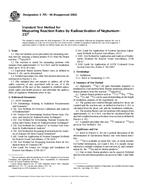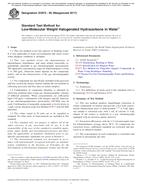1.1 This practice provides a set of instructions for estimating the environmental load of residential water, as it is discharged from a residence. The environmental load is calculated based on the number and type of fixtures in the home, the common household chemicals used, and the number of people in the home. While the format is broadly applied internationally, the parameters stated herein reflect North American averages and would need to be modified if used elsewhere.
1.1.1 Averages Method – The Averages Method provides an estimate of the annual environmental load for the average U.S. single-family home based on 2000 U.S. Census and 2007 U.S. Census Data and U.S. EPA/625/R-00/008 characterization of residential wastewater flows.
1.1.2 Unique Product Parameters Method – The Unique Product Parameters Method provides an estimate of the annual environmental load, where the home/product parameter values are the same as those used for the Averages Method except for estimated amounts of chemical contaminants listed in Table 1 or average total annual use of products as listed in Table 1, or both.
1.1.3 Adjusted Averages Method – The Adjusted Averages Method provides an estimate of the annual environmental load, where home/product parameter values differ from those used for the Averages Method, except that chemical contaminants associated with products do not vary. (Table 1 remains the same for: Typical Water Contaminants, Estimated Amount of Contaminant in Product (%), and the Percent Waste.)
1.1.4 Additional/Alternative Chemicals Method – The Additional/Alternative Chemicals Method provides an estimate of the annual environmental load, of chemicals used that are not listed in Table 1.
1.1.5 The Unique Product Parameters Method, Adjusted Averages Method, and Additional Chemicals Method may be used in combination with each other.
1.2 Instructions are provided for a single-family home. Estimates may be expanded to an aggregate number of single-family homes by assuming an average home size and multiplying by the number of homes. Estimates may be adapted to multi-unit residential buildings by factoring the home parameters for size, occupancy, and fixtures as necessary.
1.3 For the purpose of this practice, environmental load refers to chemical contaminants that may be dissolved or suspended in water.
1.3.1 Estimates of environmental load do not include organic matter common for urine, feces, and vomit.
1.3.2 Estimates of environmental load do not include bulk food waste such as kitchen scraps.
1.3.3 Estimates of environmental load do not include bulk cellulose waste such as toilet paper.
1.3.4 Actual environmental load may vary depending on types and amounts of chemicals used in a specific home and the number of people in the home.
Product Details
- Published:
- 01/01/2011
- Number of Pages:
- 12
- File Size:
- 1 file , 180 KB


